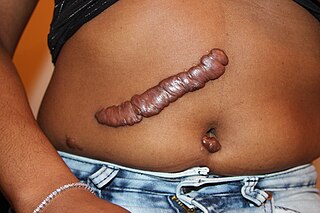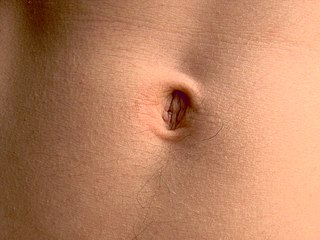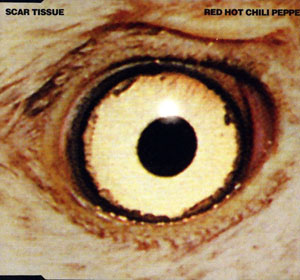Related Research Articles

A scar is an area of fibrous tissue that replaces normal skin after an injury. Scars result from the biological process of wound repair in the skin, as well as in other organs, and tissues of the body. Thus, scarring is a natural part of the healing process. With the exception of very minor lesions, every wound results in some degree of scarring. An exception to this are animals with complete regeneration, which regrow tissue without scar formation.

In archaeology, a lithic flake is a "portion of rock removed from an objective piece by percussion or pressure," and may also be referred to as simply a flake, or collectively as debitage. The objective piece, or the rock being reduced by the removal of flakes, is known as a core. Once the proper tool stone has been selected, a percussor or pressure flaker is used to direct a sharp blow, or apply sufficient force, respectively, to the surface of the stone, often on the edge of the piece. The energy of this blow propagates through the material, often producing a Hertzian cone of force which causes the rock to fracture in a controllable fashion. Since cores are often struck on an edge with a suitable angle (<90°) for flake propagation, the result is that only a portion of the Hertzian cone is created. The process continues as the flintknapper detaches the desired number of flakes from the core, which is marked with the negative scars of these removals. The surface area of the core which received the blows necessary for detaching the flakes is referred to as the striking platform.

Keloid, also known as keloid disorder and keloidal scar, is the formation of a type of scar which, depending on its maturity, is composed mainly of either type III (early) or type I (late) collagen. It is a result of an overgrowth of granulation tissue at the site of a healed skin injury which is then slowly replaced by collagen type 1. Keloids are firm, rubbery lesions or shiny, fibrous nodules, and can vary from pink to the color of the person's skin or red to dark brown in color. A keloid scar is benign and not contagious, but sometimes accompanied by severe itchiness, pain, and changes in texture. In severe cases, it can affect movement of skin. In the United States keloid scars are seen 15 times more frequently in people of sub-Saharan African descent than in people of European descent. There is a higher tendency to develop a keloid among those with a family history of keloids and people between the ages of 10 and 30 years.

The navel is a protruding, flat, or hollowed area on the abdomen at the attachment site of the umbilical cord. All placental mammals have a navel, although it is generally more conspicuous in humans.

Daron Malakian is an Armenian-American musician. He is best known as the guitarist, songwriter, and second vocalist of metal band System of a Down, and as the lead vocalist, lead guitarist, multi-instrumentalist, and songwriter of Scars on Broadway. Malakian is known for his distinctive playing and is ranked 47th in Loudwire's list of "Top 50 Hard Rock + Metal Guitarists of All Time" and number 11 in MusicRadar's poll "The 20 Greatest Metal Guitarists Ever". He is placed 30th in Guitar World's list of "The 100 Greatest Heavy Metal Guitarists of All Time".

The FNSCAR is a family of gas-operated short-stroke gas piston automatic rifles developed by Belgian manufacturer FN Herstal (FN) in 2004. It is constructed with modularity for the United States Special Operations Command (SOCOM) to satisfy the requirements of the SCAR competition. This family of rifles consist of two main types. The SCAR-L, for "light", is chambered in 5.56×45mm NATO and the SCAR-H, for "heavy", is chambered in 7.62×51mm NATO. Both are available in Close Quarters Combat (CQC), Standard (STD), and Long Barrel (LB) variants.

The Scientific Committee on Antarctic Research (SCAR) is an interdisciplinary body of the International Science Council (ISC). SCAR coordinates international scientific research efforts in Antarctica, including the Southern Ocean.

"Scar Tissue" is the first single from American rock band Red Hot Chili Peppers' seventh studio album, Californication (1999). Released on May 25, 1999, the song spent a then-record 16 consecutive weeks atop the US Billboard Hot Modern Rock Tracks chart as well as 10 weeks atop the Billboard Mainstream Rock Tracks chart, and it reached number nine on the Billboard Hot 100. It was also successful in Iceland, New Zealand, and Canada, reaching numbers one, three, and four, respectively. In the United Kingdom, it charted at number 15 on the UK Singles Chart.

The Lion King is a musical play based on the 1994 Walt Disney Animation Studios' animated feature film of the same name with music by Elton John, lyrics by Tim Rice, and book by Roger Allers and Irene Mecchi, along with additional music and lyrics by Lebo M., Mark Mancina, Jay Rifkin, Julie Taymor, and Hans Zimmer. Directed by Taymor, the musical features actors in animal costumes as well as giant, hollow puppets. The show is produced by Disney Theatrical Productions.

A scarred tree or scar tree, also known as a canoe tree and shield tree, is a tree which has had bark removed by Aboriginal Australians for the creation of bark canoes, shelters, weapons such as shields, tools, traps, containers or other artefacts. Carved trees are created as a form of artistic and spiritual expression by some Aboriginal peoples, to mark sites of significance such as burial sites.

The Antarctic Place-names Commission was established by the Bulgarian Antarctic Institute in 1994, and since 2001 has been a body affiliated with the Ministry of Foreign Affairs of Bulgaria.

Daron Malakian and Scars on Broadway is an American rock band founded by Daron Malakian of the metal band System of a Down. The band's self-titled debut album was released in July 2008.

Scarred is a television program that debuted on MTV on April 10, 2007. On each episode of Scarred, several real-life risk-takers share the stories of how they were scarred or injured while attempting dangerous stunts on primarily skateboards, but occasionally on in-line skates, skis, snowboards, and bikes.

Pastra Glacier is a 4.8 km long and 2 km wide glacier in the central part of Trinity Island in the Palmer Archipelago, Antarctica. Draining northwards to flow into Milburn Bay.

Scar is a fictional lion and the main antagonist in Disney's The Lion King franchise. He was created by screenwriters Irene Mecchi, Jonathan Roberts, and Linda Woolverton, and animated by Andreas Deja. Scar is introduced in the first film as the ruthless, power-hungry brother of Mufasa, ruler of the Pride Lands. Originally first-in-line to Mufasa's throne until he is suddenly replaced by Mufasa's son Simba, Scar decides to lead an army of hyenas in his plot to take the throne by killing Mufasa and exiling Simba, ultimately blaming his brother's death on his nephew.

Cervellati Glacier is the 5 nmi long glacier situated southeast of Patton Glacier and northwest of Ramorino Glacier on the east slope of Sentinel Range in the Ellsworth Mountains, Antarctica. It flows northeastwards between Tyree Ridge and Epperly Ridge, and enters Crosswell Glacier southeast of Mount Bearskin. The feature was named by US-ACAN in 2006 after Roberto Cervellati, Italian representative to the SCAR Expert Group on Geographic Information, 1992–2006, and director of the SCAR Composite Gazetteer of Antarctica in the same period.

Ramorino Glacier is the 4.5 nautical miles long glacier situated northwest of upper Crosswell Glacier and southeast of Cervellati Glacier on the east slope of Sentinel Range in the Ellsworth Mountains, Antarctica. It flows northeastwards between Epperly Ridge and Shinn Ridge, and enters Crosswell Glacier northwest of Mount Segers. The feature was named by US-ACAN in 2006 after Maria Chiara Ramorino, manager of the Italian team that compiled and promulgated the SCAR Composite Gazetteer of Antarctica, 1998–2006.
"The Madness of King Scar" is a song written by English musician Elton John and lyricist Tim Rice, which premiered in the musical The Lion King, a stage adaptation of Disney's 1994 animated film of the same name. "The Madness of King Scar" had been added to the musical along with two other songs. It is one of two tracks that more prominently features vocals from the character Nala. The title is a reference to the 1994 film The Madness of King George.

The Lion Guard is an American animated television series developed by Ford Riley and based on Disney's 1994 film The Lion King. The series was first broadcast with a television film titled The Lion Guard: Return of the Roar on Disney Channel on November 22, 2015, and began airing as a TV series on January 15, 2016, on Disney Junior. It is the second television series to be based on The Lion King, the first being Timon & Pumbaa (1995–1999). The Lion Guard is a sequel and spin-off to The Lion King, and takes place during the time-gap within the 1998 film The Lion King II: Simba's Pride, with the third and final season taking place in parallel with the film's second act, followed by the final two episodes of the series serving as an epilogue to the film.
References
- ↑ Freedberg (2003). Fitzpatrick's Dermatology in General Medicine (6th ed.). McGraw-Hill. p. 729. ISBN 978-0-07-138076-8.